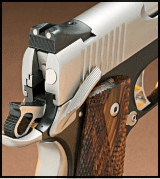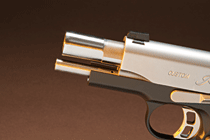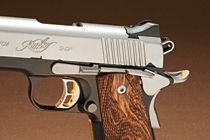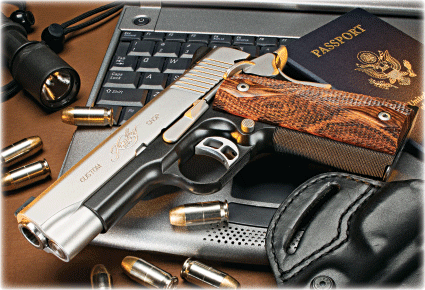I first became aware of Kimber as a 1911 provider in the mid-1990s, shortly after I started writing articles. The Custom Classic was my first exposure to the brand and it was an eye-opening experience. I had become accustomed to 1911 pistols with small sights and an inability to function with hollow-point ammo as well as 1911s that had been toyed around with by the guys that could repair Uncle Joe’s shotgun, but had no experience with Uncle Sam’s pistol.
New out of the box, the Kimber Custom Classic consumed volumes of .45ACP, including factory loads and commercially re manufactured ammo without a stoppage. It has some years on it now and it still runs whenever it’s called on. There’s been nothing done to it. It has the remainder of the factory finish, the factory trigger pull, the same parts it did when it left except for recoil spring replacement at regular intervals. It needs to have the full-length guide rod removed and GI parts installed. I’ve meant to get around to that for some years. Otherwise, it’s a good a .45 as I’ve ever owned.
manufactured ammo without a stoppage. It has some years on it now and it still runs whenever it’s called on. There’s been nothing done to it. It has the remainder of the factory finish, the factory trigger pull, the same parts it did when it left except for recoil spring replacement at regular intervals. It needs to have the full-length guide rod removed and GI parts installed. I’ve meant to get around to that for some years. Otherwise, it’s a good a .45 as I’ve ever owned.
It took some time before I became aware of the Pro series. Rendered with a shorter barrel and an alloy frame, it’s the more-or-less “Commander” equivalent in the Kimber line. Featuring a bull barrel, no bushing and a full-length guide rod, it wasn’t quite what I was seeking, but I’ve shot a number of them and owned a couple over the years. They gave me no reason to curse them because they worked.
Advertisement — Continue Reading Below
On top of that, they were a pleasure to carry. I’m not fond of .45ACP +P in any auto, less so in lightweight guns. That may prove I’m a lightweight, but I don’t see the point. It wears springs and parts quicker and gives little ballistic advantage in return. Add the lapse in split times and you have a lose-lose situation.
There were some standouts in that field like the CorBon 185-grain JHP, but mostly I avoid such loads especially in light guns. The Pro series shared the Kimber mark and, in my experience, Kimber reliability. I found them to be a good compromise; they were light but powerful, easy to carry and accurate.
Frankly, I was surprised by the first Kimber Custom Shop gun I tried. That was the Custom Eclipse back when it was a Custom Shop-only gun. A fine shooter, reliable and solid, it accompanied me to Amarillo, Texas, on a training class. That gun sure got a workout. It also got acclaim from students who shot it during training.
Advertisement — Continue Reading Below
That’s a part of the country where the 1911 is still well thought of. The Eclipse gave them no reason to change their opinions. Come to think of it, that’s another Kimber I need to install the GI recoil system onto.
Gun Details
Since that time, I’ve tried a few other Kimber Custom Shop creations. I’ve been pleased with them all. The  Kimber Custom Shop CDP (Custom Defense Package) is one I’ve had my eye on for some years. Extremely rounded and dehorned, it’s a two-tone 1911 with a striking appearance. My selection for evaluation was the Pro CDP II.
Kimber Custom Shop CDP (Custom Defense Package) is one I’ve had my eye on for some years. Extremely rounded and dehorned, it’s a two-tone 1911 with a striking appearance. My selection for evaluation was the Pro CDP II.
The 4-inch, bushingless bull barrel format is carried over as well as the classic Kimber low mount sights. The rear sight is nicely serrated along its bottom half below the white-outline tritium windows. The front sight also has a white outlined tritium vial.
Advertisement — Continue Reading Below
The frame is black finished aluminum alloy. The frontstrap and bottom of the triggerguard are nicely checkered. The slide stop, ambidextrous safety levers, magazine release button and components, grip safety, plunger tube, transverse pin, mainspring housing and mainspring housing pin are rendered in silver, some of these parts no doubt being stainless steel.
The trigger is a ventilated silver aluminum affair. The stock screws are stainless hex head screws. They hold double-diamond checkered rosewood stocks that nicely contrast with the black and silver motif. The slide is frosted stainless steel, nicely melted. The entire gun has been unsharpened and deburred. It was rounded like a well-used bar of soap. While the Pro CDP II is smooth all over, it makes me think about is a used bar of soap.
The trigger breaks at around 4 pounds and feels firm to the break. The reset is likewise solid. The safety operation bespeaks a well-fitted unit and it has a pronounced “click” on and off. The gun feels like a nice, light 1911, which is what it is. Our shooting test was truncated by travel and required chores. We spent all too little time with the Pro CDP II.
Advertisement — Continue Reading Below
 The CDP II pistols are an exceptional value, even amongst Kimbers. Each model features a collection of the most popular Custom Shop features that are added as the pistol is produced. The resulting savings can be more than $500 if these features were added separately.
The CDP II pistols are an exceptional value, even amongst Kimbers. Each model features a collection of the most popular Custom Shop features that are added as the pistol is produced. The resulting savings can be more than $500 if these features were added separately.
Range Time
Our friends at 5.11 Tactical provided their new holster and magazine pouch setup. At first reminiscent of Kydex, it became apparent that 5.11 Tactical had partnered with Blade-Tech to provide this new line of synthetic holsters.
These are of the Revolution Line; the holster and magazine pouches are made from a proprietary blend of polymers that have a wide operating temperature range. The material is very slick, allowing a very quick draw. It’s also slick enough that it doesn’t hold dust the way that some natural and manmade materials do, lessening finish wear on your favorite pistol.
Advertisement — Continue Reading Below
5.11 Tactical sells the Revolution holster with a belt loop slide and with a paddle. The paddle is handy for quick removal for the pistol licensee that has to unarm to enter an establishment where carry is prohibited.
Working out to learn the new pistol, I did several “draw to a hit” repetitions from 7 yards. The time averaged out to just over 1.15 seconds. The quickest time was just under a second with the slowest running just over 1.25.
 My friends at Kimber also provided a pair of KimPro Tac-Mags, eight-shot stainless steel magazines, for the gun test. I’ve used these before and they have proven to be quite reliable in Kimber 1911s as well as other manufacturers.
My friends at Kimber also provided a pair of KimPro Tac-Mags, eight-shot stainless steel magazines, for the gun test. I’ve used these before and they have proven to be quite reliable in Kimber 1911s as well as other manufacturers.
Advertisement — Continue Reading Below
I worked on a handling test using a B-27 repair center for a large silhouette. The repair centers cover from the 8-ring in, covering the center of shot-out PPC targets. While I had a few rounds escape into the 8-ring, those were my fault, trying to outrun my skill level, the center of the target was cut to pieces from Speer Lawman 185-grain TMJ bullets.
The Pro CDP II was all I’ve come to expect from Kimber and their Custom Shop. However, the accuracy test ended up being a rushed affair as the range was awash with hunters preparing for rifle season. I had to settle for standing unsupported from 15 yards so as to let others “play through.” Mike Rafferty stood behind me, checking out the Kimber’s progress.
He was suitably impressed with the first load out of the chute, Winchester’s 230-grain SXT. This was the accuracy load for the little custom pistol, giving a 2.5-inch five-shot group. The best three cut into one 0.75-inch hole.
Advertisement — Continue Reading Below
Fiocchi 200-grain FMJ put five bullets into 3.25 inches, with three giving us 1.25-inch accuracy. Finally, Hornady 200-grain XTP/JHP—an above-average performer in every gun tried to date and an accuracy load in others—gave us a group with shots falling into a 2.5-inch group.
Final Notes
The Kimber CDP II line is still a strong seller as it has been for several years. Frankly, I took too long to get to it. The Kimber was quick to the target from the 5.11 Tactical/Blade Tech Revolution holster. The KimPro Tac-Mags performed flawlessly. If you are in the market for a custom carry pistol, check out the Pro CDP II.























